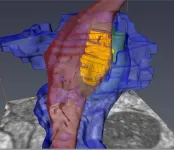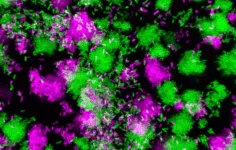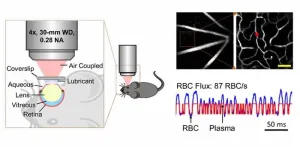(Press-News.org) New research indicates the fungal pathogen Batrachochytrium salamandrivorans (Bsal) could be devastating to amphibian biodiversity if introduced to North America. Nature Communications published the findings June 5 from a group of researchers at the University of Tennessee Institute of Agriculture, the University of Massachusetts-Boston and Washington State University.
“We could see over 80 species of salamanders in the United States and 140 species in North America experience population declines if Bsal is introduced,” said Matt Gray, the lead author and professor of wildlife health in the UT School of Natural Resources. Amphibians are an important form of natural mosquito control in our environment. They are also important to medical research because of their ability to regenerate limbs and the natural analgesics, or pain killers, they produce. Some of the peptides from their skin can actually inactivate some viruses detrimental to humans, including HIV.
However, Bsal erodes and destroys the skin of amphibians. The fungal pathogen was discovered 10 years ago in fire salamander populations in Europe but has not yet been detected in the western hemisphere. The article’s authors began experiments evaluating the risk to North American amphibians in 2016.
“Some of our most common salamander species, like the eastern newt, could be wiped out,” Gray said. The research predicts the greatest declines could be seen in the Appalachian Mountains and Pacific Northwest, where climate conditions are ideal for Bsal and salamander numbers are the greatest.
“Many of the salamanders in the Smokies are lungless and breath entirely through their skin,” said co-author Debra Miller, veterinary pathologist with the UT One Health Initiative. “So a fungus that destroys the skin can affect their ability to respire and maintain healthy levels of important electrolytes in their bodies.” In a separate publication, Miller and colleagues reported that changes in skin function and electrolytes in the blood from Bsal infection can lead to paralysis, which is often seen in sick animals.
In the Nature article, the authors encourage the U.S., Canada and Mexico to consider developing a healthy trade certification program that promotes the sale of amphibians that are not infected by chytrid fungi and ranaviruses. The article says wildlife trade involves more than 180 nations and generates $300 billion annually.
In another study published in June in Business Strategy and the Environment, Kevin Cavasos, of the UT One Health Initiative; Gray and colleagues report the majority of U.S. businesses support a healthy trade certification program. Neelam Poudyal, professor of natural resource policy in the UT School of Natural Resources, said, “Our initial surveys of pet amphibian owners suggest they are concerned about these pathogens and may be willing to spend approximately 75% more for amphibians that are not infected.”
Gray, Poudyal and others recently began a study supported by the National Science Foundation to investigate pathogen movements in pet amphibian trade and the willingness of the industry to adopt healthy trade practices.
Gray said, “Wildlife trade can contribute to the global spread of various pathogens, even those that can cause disease in humans. It is important to support healthy trade programs to reduce business losses and threats to our native biodiversity and safeguard public health.”
More information about Gray and Poudyal’s healthy trade research as well as opportunities for U.S. pet amphibian businesses to receive free pathogen testing can be found at healthyamphibiantrade.org.
The research performed in the Nature Communications article was supported by 14 organizations, including the National Science Foundation and BAND Foundation.
The UT School of Natural Resources is part of the Herbert College of Agriculture, UT AgResearch and UT Extension at the University of Tennessee Institute of Agriculture. The curricula focus on a mastery learning approach, emphasizing practical, hand-on experiences. The school’s faculty, staff and students conduct research and extension that advances the science and sustainable management of our natural resources. For more information, visit naturalresources.tennessee.edu.
Through its land-grant mission of research, teaching and extension, the University of Tennessee Institute of Agriculture touches lives and provides Real. Life. Solutions. utia.tennessee.edu
END
UTIA researchers find high risk to amphibians if fungal pathogen invades North America
Consequences of introduction could be severe to native species
2023-06-14
ELSE PRESS RELEASES FROM THIS DATE:
New images capture unseen details of the synapse
2023-06-14
Scientists have created one of the most detailed 3D images of the synapse, the important juncture where neurons communicate with each other through an exchange of chemical signals. These nanometer scale models will help scientists better understand and study neurodegenerative diseases such as Huntington’s disease and schizophrenia.
The new study appears in the journal PNAS and was authored by a team led by Steve Goldman, MD, PhD, co-director of the Center for Translational Neuromedicine at the University of Rochester and the University of Copenhagen. The findings represent a significant technical achievement ...
New UCF project launched to engage a diverse, new generation of researchers to aid aging populations
2023-06-14
ORLANDO, June 14, 2023 — The number of older adults in the U.S. population is growing, expecting to nearly double by 2060, and becoming more diverse with racial and ethnic minority populations projected to increase by 105% by 2040.
“As a society, we’re not ready for that,” says Norma Conner, a professor in the University of Central Florida’s College of Nursing. “We need to be cognizant of the large population of older adults that is going to be ours to care for, and we need to have a better understanding that reflects them.”
To ...
Stanford Medicine and Stanford Institute for Human-Centered Artificial Intelligence announce RAISE-Health, a responsible AI initiative
2023-06-14
Responding to rapid advances in artificial intelligence and the urgent need to define its responsible use in health and medicine, Stanford Medicine and the Stanford Institute for Human-Centered Artificial Intelligence (HAI) today announced the launch of RAISE-Health (Responsible AI for Safe and Equitable Health). This pioneering initiative seeks to address critical ethical and safety issues surrounding AI innovation and help others navigate this complex and evolving field.
Co-led by Stanford School ...
Scientists discover small RNA that regulates bacterial infection
2023-06-14
People with weakened immune systems are at constant risk of infection. Pseudomonas aeruginosa, a common environmental bacterium, can colonize different body parts, such as the lungs, leading to persistent, chronic infections that can last a lifetime – a common occurrence in people with cystic fibrosis.
But the bacteria can sometimes change their behavior and enter the bloodstream, causing chronic localized infections to become acute and potentially fatal. Despite decades of studying the transition in lab environments, how and why the switch happens in humans has remained unknown.
However, researchers ...
Making immunotherapy safer
2023-06-14
Researchers at the University of Houston are working to make T-cell immunotherapy safer, developing a tool called CrossDome, which uses a combination of genetic and biochemical information to predict if T-cell immunotherapies might mistakenly attack healthy cells.
T-cell based immunotherapies hold tremendous potential in the fight against cancer and infectious diseases, thanks to their capacity to specifically target diseased cells, including cancer metastasis. Nevertheless, this potential has been tempered with safety concerns regarding ...
Eyeing the brain: Predicting cerebrovascular diseases with retinal imaging
2023-06-14
The brain is one of the most metabolically active organs in the human body. Although it represents only about 2 percent of the human body’s weight, it receives 15 to 20 percent of the body’s total blood supply. Disrupted blood flow to the brain over a long period of time, a condition known as “chronic cerebral hypoperfusion” (CCH), can lead to serious cerebrovascular diseases such as white matter disease.
CCH manifests as lesions in the white matter, a brain region vulnerable to problems with blood supply. Unfortunately, CCH has no available cure. An early diagnosis by visualizing the microvascular changes in the brain that occur prior to lesion ...
Phone Menu Test Detects Who May Be at Risk of Alzheimer’s Disease
2023-06-14
A new study by investigators from Mass General Brigham has found that a brief, simulated task of navigating a phone menu can detect the earliest changes in daily functioning in people at risk of developing Alzheimer’s disease. Investigators found that an older adult’s performance on the test, which can be completed in a matter of minutes, was associated with the hallmarks of Alzheimer’s disease pathology, including amyloid and tau depositions in the brain. The findings, which were published in the Journal of Alzheimer’s Disease, could help inform prevention trials testing treatments for Alzheimer’s disease before ...
When local economic inequality is high, the rich tend to be more generous
2023-06-14
Rich individuals living in communities with greater levels of economic inequality tend to be more generous with charitable giving and prosocial behaviors, according to a study published June 14, 2023 in the open-access journal PLOS ONE by Joel H. Suss from the London School of Economics & Political Science and Bank of England, UK.
Many studies have attempted to assess whether the rich are more or less generous than the poor, and whether this shifts depending on the starkness of economic inequality. Thus far, the results have been inconclusive. Previous work in this vein has been conducted at a macro level, using state, region, and country-level aggregated data. In this study, Suss ...
Ocean current comes to the rescue for Pacific island reefs
2023-06-14
Marine heatwaves are emerging as a key impact of climate change and pose a particularly significant threat to corals that form the backbone of coral reefs. Researchers have now identified a phenomenon that could help coral reef managers better plan and act for the future.[1]
Every few years, the cyclic climate pattern called El Niño arises in the tropical Pacific, causing significant changes in winds, weather and ocean temperatures. From April 2015 to May 2016, the Central Pacific witnessed one of the strongest El Niño events ever recorded.
Coral reefs were so stressed by the warmer ocean temperatures that they experienced mass bleaching, whereby the ...
'Smart' drugs can decrease productivity in people who don't have ADHD, study finds
2023-06-14
New research from the University of Cambridge and the University of Melbourne, published in Science Advances, shows neurotypical workers and students taking cognitive enhancers, or ‘smart’ drugs, may actually be inhibiting their performance and productivity.
Drugs such as methylphenidate, sold under the brand name Ritalin among others, are commonly prescribed for attention deficit hyperactivity disorder (ADHD), but are also taken by those without a diagnosis, in the belief that the drugs will enhance focus and cognitive performance.
In four double-blinded, ...
LAST 30 PRESS RELEASES:
Society for Laboratory Automation and Screening welcomes new scientific director: Madeline M. Farley, Ph.D.
Austrian cow shows first case of flexible, multi-purpose tool use in cattle
Human nasal passages defend against the common cold and help determine how sick we get
Research alert: Spreading drug costs over the year may ease financial burden for Medicare cancer patients
Hospital partnership improves follow up scans, decreases long term risk after aortic repair
Layered hydrogen silicane for safe, lightweight, and energy-efficient hydrogen carrier
Observing positronium beam as a quantum matter wave for the first time
IEEE study investigates the effects of pointing error on quantum key distribution systems
Analyzing submerged fault structures to predict future earthquakes in Türkiye
Quantum ‘alchemy’ made feasible with excitons
‘Revoice’ device gives stroke patients their voice back
USF-led study: AI helps reveal global surge in floating algae
New method predicts asthma attacks up to five years in advance
Researchers publish first ever structural engineering manual for bamboo
National poll: Less than half of parents say swearing is never OK for kids
Decades of suffering: Long-term mental health outcomes of Kurdish chemical gas attacks
Interactional dynamics of self-assessment and advice in peer reflection on microteaching
When aging affects the young: Revealing the weight of caregiving on teenagers
Can Canada’s health systems handle increased demand during FIFA World Cup?
Autistic and non-autistic faces may “speak a different language” when expressing emotion
No clear evidence that cannabis-based medicines relieve chronic nerve pain
Pioneering second-order nonlinear vibrational nanoscopy for interfacial molecular systems beyond the diffraction limit
Bottleneck in hydrogen distribution jeopardises billions in clean energy
Lung cancer death rates among women in Europe are finally levelling off
Scientists trace microplastics in fertilizer from fields to the beach
The Lancet Obstetrics, Gynecology, & Women’s Health: Taking paracetamol during pregnancy does not increase risk of autism, ADHD or intellectual disabilities, confirms new gold-standard evidence review
Taking paracetamol during pregnancy does not increase risk of autism, ADHD or intellectual disabilities
Harm reduction vending machines in New York State expand access to overdose treatment and drug test strips, UB studies confirm
University of Phoenix releases white paper on Credit for Prior Learning as a catalyst for internal mobility and retention
Canada losing track of salmon health as climate and industrial threats mount
[Press-News.org] UTIA researchers find high risk to amphibians if fungal pathogen invades North AmericaConsequences of introduction could be severe to native species






